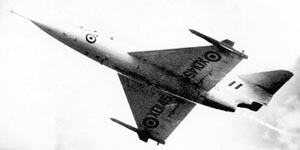Saunders-Roe SR.53
|
|
| Saunders-Roe SR.53 | ||
|---|---|---|

| ||
| Description | ||
| Role | Prototype interceptor | |
| Crew | one, pilot | |
| First Flight | May 16 1957 | |
| Manufacturer | Saunders-Roe | |
| Dimensions | ||
| Length | 45 ft | 13.72 m |
| Wingspan | 25 ft 1 in | 7.65 m |
| Height | 10 ft 10 in | 3.30 m |
| Wing area | 274 ft² | 25.45 m² |
| Weights | ||
| Empty | 6,635 lb | 3,016 kg |
| Loaded | 18,361 lb | 8,346 kg |
| Maximum takeoff | lb | kg |
| Powerplant | ||
| Jet engine | 1 × Armstrong Siddeley Viper 8 | |
| Thrust | 1,640 lb | 7.3 kN |
| Rocket engine | 1 × de Havilland Spectre | |
| Thrust | 8,000 lbf | 35.7 kN |
| Performance | ||
| Maximum speed | 1,334 mph | 2,135 km/h |
| Endurance at full power | 7 minutes | |
| Service ceiling | ft | m |
| Rate of climb | 24,000 ft/min | 7,317 m/min |
| Wing loading | 67 lb/ft² | 328 kg/m² |
| Thrust/Weight | 1:2 | |
| Avionics | ||
| Avionics | ||
| Armament | ||
| Missiles | 2 × Firestreak missiles | |
The Saunders-Roe SR.53 was a prototype interceptor aircraft of mixed jet and rocket propulsion developed for the Royal Air Force in the early 1950s. Although its performance was promising, the need for such an aircraft was soon overtaken by surface-to-air missile development, and the project was cancelled after forty-two test flights.
The Second World War demonstrated the importance of strategic bombing to modern warfare, and as the Cold War developed, devising effective air defence against large waves of enemy bomber aircraft became a priority for many nations. Nazi Germany had looked to rocket-powered aircraft to fill this niche, with machines like the Messerschmitt Me 163 and Bachem Ba 349, which were capable of fantastic rates-of-climb, enabling them to (at least in theory) rise to meet and intercept enemy bombers before they reached their targets. German rocket technology was studied extensively by the Allies in the aftermath of the war, and in light of the threat of the growing Soviet strategic bomber fleet and that nation's newly-developed atomic weapons, the UK's Air Ministry drafted a requirement (O.R.301) in May 1951 for a rocket-powered interceptor that could reach an altitude of 60,000 ft (18,300 m) in just 2½ minutes. This was circulated to the nation's aircraft manufacturers the following February.
Of the seven companies that tendered designs, two were selected for development contracts, A.V. Roe with their Avro 720 and Saunders-Roe with their SR.53. The SR-53 itself was a sleek aircraft with a sharply pointed nose, delta-like wing, and a T-tail. The jet and rocket exhausts were mounted one atop the other in the tail.
By September 1953 the programme to develop these aircraft came under scrutiny due to cost cuts, and the Avro 720 was abandoned, although it seemed almost ready to fly at this point. One of the reasons for preferring the SR.53 was although the aircraft was developmentally behind, its use of hydrogen peroxide as an oxidiser was viewed as less problematic than the Avro 720's use of liquid oxygen. Nevertheless, a series of setbacks, including an explosion during ground tests of the engine, saw the aircraft's first flight fall further and further behind schedule. At the same time, Saunders-Roe began work on a derivative design, the SR.177, adapting the SR.53 design for maritime use by the Royal Navy and the German Navy.
It was 1957 before the aircraft was to take to the air, just over a month after, the infamous 1957 Defence White Paper had been published, outlining the British government's policy to largely abandon piloted aircraft in favour of concentrating on missile development. At the same time, jet engine development had progressed a long way in the six years since the SR.53's initial design. Combined with the fact that improvements in radar had meant that any incoming bomber threat could be detected much earlier, the need for an aircraft like the SR.53 had disappeared, and, unsurprisingly, the project was cancelled. One of the two SR.53 prototypes is preserved at the RAF Museum at Cosford. The other crashed during testing, killing its pilot.
| Related content | |
|---|---|
| Related Development | |
| Similar Aircraft | |
| Designation Series |
SR.53 |
| Related Lists | |
|
Lists of Aircraft | Aircraft manufacturers | Aircraft engines | Aircraft engine manufacturers Airports | Airlines | Air forces | Aircraft weapons | Missiles | Timeline of aviation |
